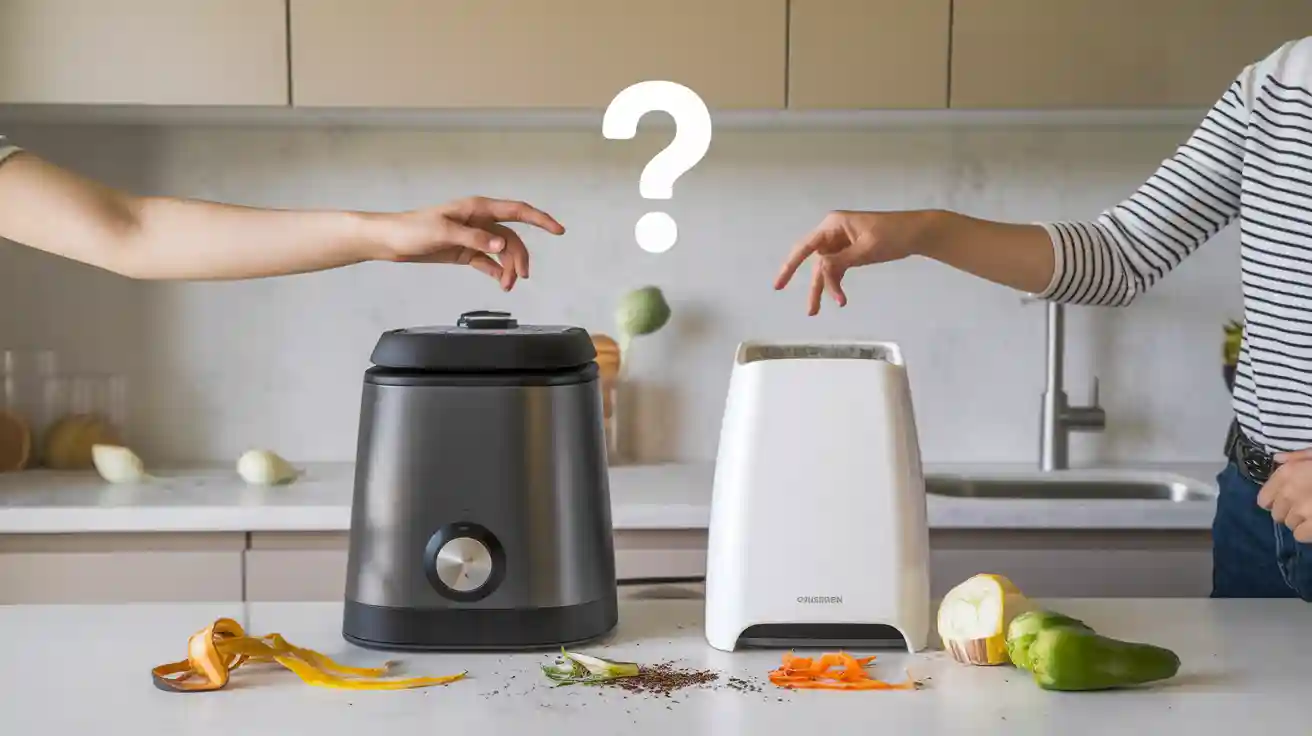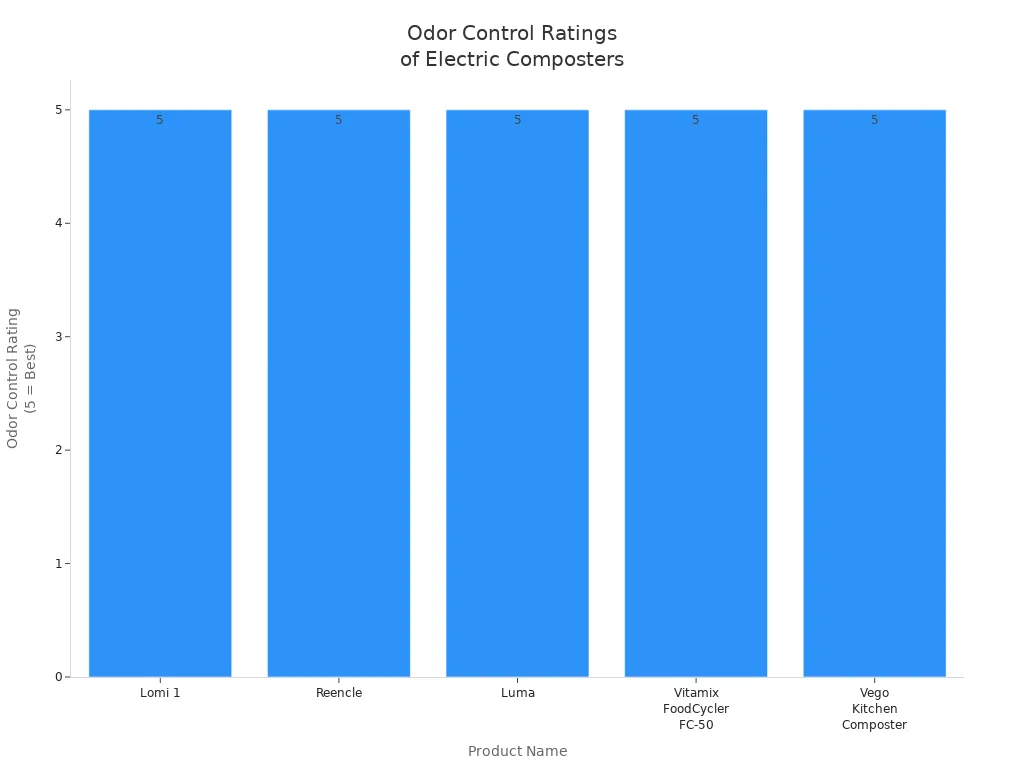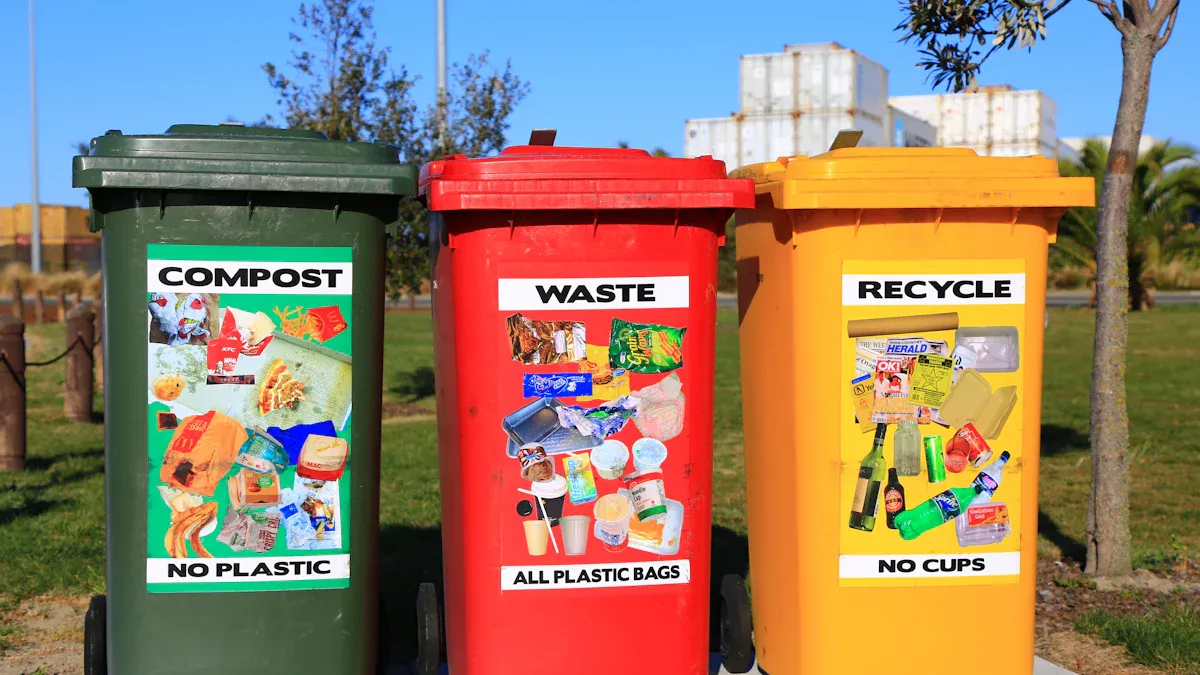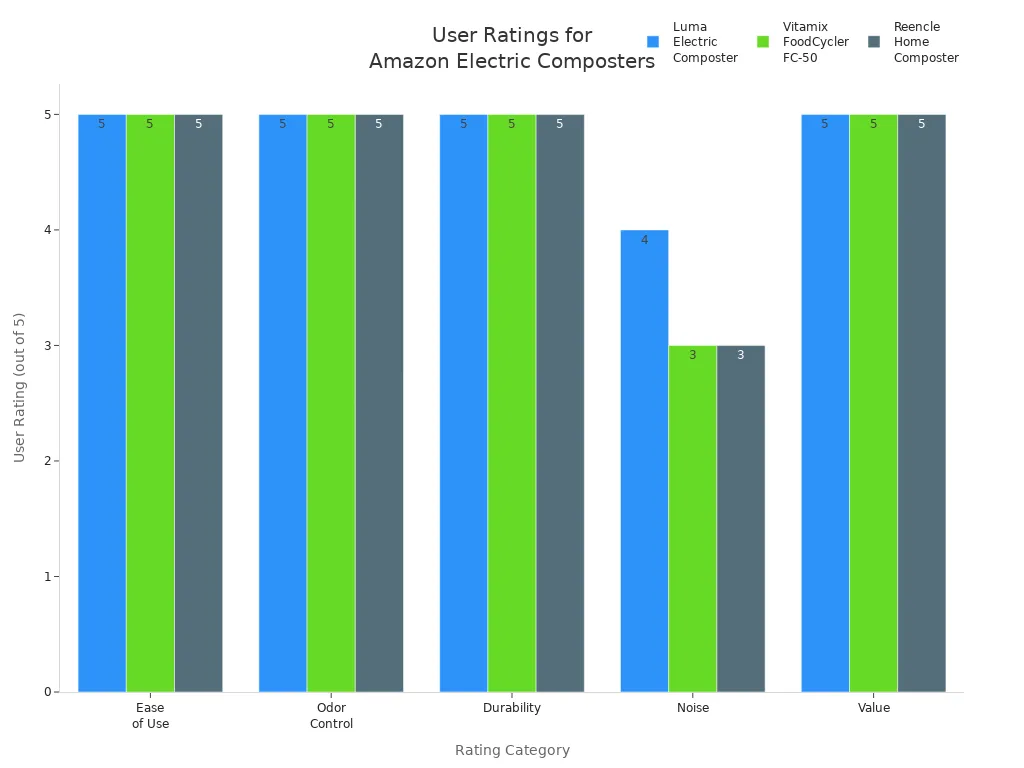
You want the best electric composter for your kitchen. For most homes, the amazon electric composter stands out as the best electric composter thanks to its convenience and strong performance. Some people may prefer a WL-S3 smart disposer if they need faster waste removal. The amazon electric composter suits eco-friendly users.
Amazon Electric Composter vs. WL-S3 Smart Disposer: Quick Comparison
Features Side-by-Side
You want to know how the electric composter and the WL-S3 smart disposer compare. Both offer smart features that make food waste management easier. The amazon electric composter uses sensors and simple controls. The WL-S3 smart disposer also includes smart features like automatic shut-off and odor control. Each electric composter fits well in small kitchens. You can use the electric kitchen composter even if you live in an apartment. The WL-S3 smart disposer works best for people who want fast waste removal. Both devices reduce food waste volume and help keep your kitchen clean.
| Features | Amazon Electric Composter | WL-S3 Smart Disposer |
|---|---|---|
| Smart Features | Sensors, simple controls | Automatic shut-off, odor control |
| Capacity | Limited, best for small kitchens | Limited, not for large volumes |
| Output | Compost (needs maturing) | Dehydrated food waste |
| Odor Control | Yes, but some sweet smell | Yes, effective for most users |
| Noise Level | Quiet operation | Quiet operation |
| Suitable For | Apartments, eco-friendly homes | Fast waste removal, urban homes |
Pros and Cons Overview
You should look at the main advantages and disadvantages before choosing a composter. Here is a quick overview:
Tip: Consider your kitchen size and how much food waste you produce each week.
| Advantages | Disadvantages |
|---|---|
| Easy to use with smart features | Uses electricity, which may affect environmental benefits |
| Reduces methane emissions | High upfront cost and ongoing electricity use |
| Fast composting process | Compost needs time to mature |
| Good for apartments | Limited capacity |
| Helps manage kitchen odors | Some odor issues after long use |
| Produces compost for plants | Not all devices make fully mature compost |
You can see that each electric composter and smart disposer has unique strengths. Choose the one that matches your needs and kitchen habits.
Electric Composter and Smart Disposer Performance
Food Waste Processing Effectiveness
You want a composter that handles food waste quickly and efficiently. The electric composter uses heat, grinding, and smart sensors to break down kitchen scraps. Most electric composters on Amazon, like the Airthereal Revive and Geme Electric Composter, process a standard load of food waste in just a few hours. The Airthereal Revive can finish a cycle in as little as 2 hours, but some loads may take up to 7 hours. The Geme Electric Composter usually takes 6 to 8 hours. Both models can handle meat, dairy, and even small bones, which makes them flexible for many types of food waste.
Here is a table that shows the average processing time for popular electric composters and the WL-S3 smart disposer:
| Product Name | Average Processing Time | Notes |
|---|---|---|
| Airthereal Revive | 2 to 7 hours | Fastest composter on Amazon; cycle time varies by scrap type; processes soft bones, dairy, and meat. |
| Geme Electric Composter | 6 to 8 hours | Larger capacity; mimics traditional composting; processes meat, dairy, small bones; allows adding waste anytime. |
| WL-S3 Smart Disposer | N/A | No specific processing time information available. |
The WL-S3 smart disposer works differently from an electric composter. You use it to grind and dehydrate food waste, but there is no clear information about how long it takes to process a full load. Many users say it removes waste quickly, but you may not get finished compost. Instead, you get dried food scraps that you can throw away or use in your garden after further composting.
You should think about what you want from your food recycler. If you want finished compost for your plants, an electric composter gives you that. If you want fast waste removal, the WL-S3 smart disposer may suit you better. Both options help you reduce the amount of food waste that goes to the landfill.
Odor Control and Speed
Odor control is a key feature in any electric composter or food recycler. You do not want your kitchen to smell bad while you process food waste. Most electric composters use filters or special technology to keep odors low. For example, the Lomi 1 uses charcoal pellets, and the Luma uses a carbon filter. Both get top marks for odor control. The Reencle uses a microbe balance, but you may notice a vinegar smell if you do not manage it well. The Vitamix FoodCycler FC-50 and Vego Kitchen Composter also use filters to stop odors.
Here is a chart that shows how well these composters control odors:

You can see that most electric composters on Amazon score 5 out of 5 for odor control. This means you can use an electric kitchen composter in your home without worrying about bad smells. The WL-S3 smart disposer also claims to control odors, but there is not much information about how well it works. You may want to check user reviews to see if it meets your needs.
Speed is another important part of performance. Electric composters usually finish a cycle in less than 8 hours. You can run a cycle overnight and wake up to finished compost. The WL-S3 smart disposer works fast to remove waste, but you may need to empty it more often if you have a lot of kitchen scraps.
Tip: If you want to compost every day, choose a composter with a short cycle time and strong odor control features.
Both the electric composter and the WL-S3 smart disposer help you manage food waste and keep your kitchen clean. You should pick the one that matches your lifestyle and composting goals.
Convenience and Usability of Smart Solutions
Installation and Setup
You want a composter that offers ease from the start. Most electric composter models arrive ready to use. You plug in the composter, follow a few steps on the app, and begin composting. The WL-S3 disposer also promises ease of use. You install it under your sink, connect it to power, and download the app for setup. The electric composter usually fits on your countertop, so you do not need extra plumbing. You can finish installation in less than 10 minutes. The app guides you through each step, making the process simple. You will notice the ease of use right away.
Daily Use Experience
You want daily tasks to feel easy. The electric composter lets you add scraps anytime. You press a button or use the app to start a cycle. The composter works quietly, so you do not hear loud noises. You get reminders from the app to empty the bin or clean the filter. The WL-S3 disposer also focuses on ease. You drop food waste into the disposer, and it grinds and dries the scraps. You control the device with the app, which adds to the ease of use. You do not need to worry about odors because both composter options include filters. You will see how ease of use improves your kitchen routine.
Maintenance Needs
You want a composter that keeps maintenance simple. The electric composter needs you to empty the compost bin and clean the filter every week. You get alerts from the app when it is time for maintenance. The WL-S3 disposer also makes maintenance easy. You remove the dried waste and rinse the container. You check the filter every month. Both composter choices focus on ease of use, so you spend less time on upkeep. You will appreciate the ease these smart solutions bring to your kitchen.
Electric Composter and Smart Disposer Cost Comparison
Upfront Price
You want to know how much you will pay at the start. The electric composter usually costs between $300 and $500. Some models on Amazon, like the Lomi or Vitamix FoodCycler, fall in this range. The WL-S3 smart disposer often costs about $400. You may find deals or discounts, but the price stays close to this amount. Here is a table to help you compare:
| Product | Average Upfront Price |
|---|---|
| Electric Composter | $300 – $500 |
| WL-S3 Smart Disposer | $400 |
You should check what comes in the box. Some electric composter models include extra filters or starter kits. The WL-S3 smart disposer may need extra parts for installation.
Ongoing Costs
You will spend money after you buy the device. The electric composter uses electricity for each cycle. You may pay about $2 to $4 each month for power. You also need to replace filters every few months. Filters cost about $20 each. The WL-S3 smart disposer also uses electricity to dry and grind waste. You will pay a similar amount for power. You need to replace its filter, too. Both devices need you to empty the waste bin and clean the parts. You do not pay for special bags or chemicals.
Tip: If you want to save money, empty the waste bin often and clean the device as the manual says.
You can see that both the electric composter and the WL-S3 smart disposer have similar ongoing costs. You should think about how much waste your home makes and how often you will use the device.
Environmental Impact of Electric Composter vs. Smart Disposer

Output Quality: Compost vs. Waste
When you use an electric composter, you expect to get compost for your plants. Most electric composters, such as the Vego Kitchen Composter and Vitamix FoodCycler FC-50, do not create traditional compost. These machines dry and grind your food waste quickly. The result is a soil additive that looks like compost but lacks the living bacteria and microorganisms found in outdoor compost piles. Some models ask you to add bacteria packets to help break down the scraps further.
You can mix the output from your electric composter with soil. The best ratio is one part dehydrated scraps to ten parts soil. This mixture is odorless and easy to handle. However, you should know that the material is not ready for direct use in your garden or on crops. The output often contains high salt, phytotoxins, and can mold if left alone. These problems can harm your plants and attract animals. Studies show that you must cure or stabilize the material before using it as a soil amendment. Right after a composting cycle, none of the processed food waste is safe for direct garden use.
The WL-S3 smart disposer works differently. It grinds and dries food scraps, but there is little information about the quality of its waste output. You may not get a product you can use in your garden. Most users throw away the dried scraps or add them to a traditional compost pile for further breakdown. If you want a food recycler that gives you finished compost, you may feel disappointed with both options. Both devices help you reduce food waste, but they do not replace traditional composting.
Note: If you want to use the output from your electric composter or food recycler in your garden, let it cure for several weeks. This step protects your plants and improves soil health.
Energy Efficiency and Sustainability
You care about the environment when you choose a composter or food recycler. Both the electric composter and the WL-S3 smart disposer use electricity to process food waste. The energy use for each cycle is low, but it adds up over time. Most electric composters use about 1 kWh per cycle, which is similar to running a small kitchen appliance. The WL-S3 smart disposer uses a similar amount of power to dry and grind scraps.
You help the planet by keeping food waste out of landfills. When food scraps break down in a landfill, they release methane, a strong greenhouse gas. By using a composter or food recycler, you cut down on methane emissions. You also reduce the number of garbage bags you use each week.
Here is a quick look at the sustainability features of each device:
| Device | Energy Use per Cycle | Reduces Landfill Waste | Compost Output | Needs Further Processing |
|---|---|---|---|---|
| Electric Composter | ~1 kWh | Yes | Yes | Yes |
| WL-S3 Smart Disposer | ~1 kWh | Yes | No | N/A |
You should remember that indoor composting with an electric food recycler is more sustainable than throwing food scraps in the trash. However, you must still process the output before using it in your garden. If you want the most eco-friendly option, consider how you will use the output and how much energy your composter uses.
Tip: Run your composter or food recycler with full loads to save energy and get the best results.
Both the electric composter and the WL-S3 smart disposer offer a cleaner way to handle food waste. You make a positive impact on the environment by choosing either device, but you must follow best practices for composting and waste management.
Best Fit: Who Should Choose an Amazon Electric Composter or WL-S3 Smart Disposer?
Ideal User Profiles
You want to pick the right composting tool for your home. The amazon electric composter works best for people who live in apartments or urban areas. Its compact size fits small kitchens, and you do not need a yard. If you care about sustainability and like using smart technology, you will enjoy features like app tracking and easy controls. The amazon electric composter also helps if you want to compost year-round, even during cold winters. People with mobility challenges benefit because you do not need to turn piles or carry heavy bins. High upfront costs mean this composter suits households with a strong interest in eco-friendly technology and a higher budget.
The WL-S3 smart disposer fits users who want fast waste removal and simple daily routines. If you have a busy lifestyle and want to keep your kitchen clean, this device helps you manage food scraps quickly. You may prefer the WL-S3 if you do not plan to use the output for gardening or composting.
Recommended Scenarios
You should consider your needs before choosing a composting solution. Here are some common scenarios:
- You live in a city apartment with limited space and want to reduce food waste: Choose the amazon electric composter.
- You want to compost indoors all year and avoid outdoor bins: The amazon electric composter is a good fit.
- You value smart features like app integration and reminders: The amazon electric composter meets your needs.
- You need to process waste quickly and do not care about making compost: The WL-S3 smart disposer is a better choice.
- You want a device that is easy to maintain and fits under your sink: The WL-S3 smart disposer works well.
Tip: Always match the composter’s capacity and features to your household’s daily waste volume and composting goals.
A table can help you decide:
| Scenario | Best Choice |
|---|---|
| Small kitchen, no yard, want compost | Amazon electric composter |
| Fast waste removal, no compost needed | WL-S3 smart disposer |
| Tech-savvy, eco-friendly, want app features | Amazon electric composter |
| Busy lifestyle, simple waste management | WL-S3 smart disposer |
You want the best electric composter for ease of use, odor control, and value. User ratings show top scores for Amazon models:
| Product | Ease of Use | Odor Control | Value |
|---|---|---|---|
| Luma Electric Composter | 5/5 | 5/5 | 5/5 |
| Vitamix FoodCycler FC-50 | 5/5 | 5/5 | 5/5 |

Both Amazon electric composters and WL-S3 smart disposers fit current sustainable home trends. Choose the best electric composter if you want compost and smart features. Pick the WL-S3 for fast waste removal. Select the device that matches your lifestyle and kitchen needs.
FAQ
Can you use meat and dairy in an electric composter?
Yes, you can add meat and dairy scraps. Most electric composters process these items safely. Always check your model’s manual for best results.
How often do you need to clean the filter?
You should clean or replace the filter every month.
- Tip: Set a reminder in your phone or app to help you remember.
Does the WL-S3 smart disposer make compost you can use in your garden?
| Device | Garden-Ready Compost |
|---|---|
| WL-S3 Disposer | No |
| Electric Composter | Needs curing |
You need to cure the output before using it in your garden.


